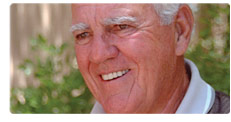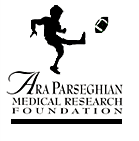The Newsletter of the
Ara Parseghian Medical Research Foundation
Spring 2006

Coach's Corner
Dear Friends,
 In football, even though you start every game with a game plan, anything can happen. You study your opponents, develop offensive and defensive strategies, design plays, run drills and make a starting lineup. But once the ball is in motion, the game takes on a life of its own. That is the beauty of football...watching a plan on paper become bigger and better than you had ever envisioned through the imagination, intelligence, resourcefulness and skill of coaches and players in the moment.
In football, even though you start every game with a game plan, anything can happen. You study your opponents, develop offensive and defensive strategies, design plays, run drills and make a starting lineup. But once the ball is in motion, the game takes on a life of its own. That is the beauty of football...watching a plan on paper become bigger and better than you had ever envisioned through the imagination, intelligence, resourcefulness and skill of coaches and players in the moment.
In many ways the Ara Parseghian Medical Research Foundation has been just like football.
This year, as we celebrate the 11th Annual "One More Victory, Ara!" Celebrity Golf Weekend and Gala, we also celebrate a non-profit organization that has grown to touch more lives than we had ever imagined through research that has ramifications for neurodegenerative diseases, cholesterol metabolism disorders and heart disease. The APMRF also stands as testament to foundations and scientists working toward drug trials for thousands of other little-known diseases whose research might eventually impact millions.
I want to take this opportunity to personally pay tribute to each of the generous volunteers and to the dedicated, visionary sponsors who have embraced our Goal for Life. And I want to thank each of you for your support, your prayers and your presence. You have given the APMRF a life of its own, making it bigger than one family, one cause or one disease. You are impacting lives and making the world a better place, and that is the ultimate victory.
Sincerely,
Coach Ara Parseghian
Back to top

The Notre Dame Family Cares
Forty years ago when Ara Parseghian was coaching football at the University of Notre Dame, and 30 years ago when Cindy and Mike Parseghian were undergrads, they had no idea how their lives would continue to be impacted by the family that is Notre Dame.
From the Alumni Clubs to the Athletic Office and Department of Chemistry, “Domers” have played a key role in the support of the Parseghian family and in the work of the Ara Parseghian Medical Research Foundation.
Most recently, the Notre Dame Club of Phoenix presented Cindy and Mike a donation of $3,000 given during a special Mass on Fiesta Bowl Weekend. The Club in Houston mailed a check resulting from their annual golf outing. Milwaukee alumni are busy planning for their “Ara’s Outing 2006” which nets the Foundation more than $30,000 each year.
In 2000 Ed Armento, ND ’65, challenged his classmates at a 35th Anniversary Reunion to give to the work of the APMRF. As a result, this class has contributed more than $80,000 in the past six years. Each year Ed has written to the presidents of the classes that followed to challenge them to do the same at their annual reunions.
The scientific community at Notre Dame has also rallied behind the cause offering the services and expertise of their Chemistry Department to conduct important research on compounds that may prove effective with NP-C patients.
Our sincere thanks to everyone associated with Notre Dame who has reached out to love and support the Parseghian family in their fight against Niemann-Pick Type C disease.
Back to top

What Rare Diseases Can Teach Us
Research into many maladies is underfunded. This hurts patients and prevents science from unlocking the keys to the body.
By Steven U. Walkley
(Excerpts taken from his op-ed article that appeared in the September 3, 2005 issue of the Los Angeles Times.)
This summer, 8-year-old Jessica Leoni was admitted to UCLA Medical Center for treatment of seizures brought on by a rare neurological disease called Niemann-Pick Type C, or NP-C. After 11 days, her doctors finally identified a drug that could hopefully control her seizures, and she returned to her Westchester home with her relieved parents.
But this family’s relief is bound to be tempered by the knowledge that there is no known cure for NP-C and, because it is so rare, research to find a cure is badly underfunded.
And NP-C is only one of about 6,000 such diseases, identified by the National Institutes of Health as ailments that each affect fewer than 200,000 Americans.
Both the government and private drug companies too often look at such numbers and say no to the funding required to finding treatments and cures. But that traditional calculus is incomplete — there are plenty of good reasons to do more to fund rare-disease research.
First, even rare diseases affect a huge number of people. Nearly 25 million Americans suffer from one of the conditions that the National Institutes of Health lists as rare.
The financial and emotional burdens on our society of not adequately treating such illnesses are immeasurable.
In addition, however, such research also has ramifications far beyond the individual sufferers. Rare diseases represent unique windows that allow scientists to peer into the intricate workings of our bodies.
Researching diseases such as NP-C could be illuminating for many other diseases. Brain cells in children with this disease are characterized by the formation of abnormal “tangles” that are identical to those of adults with Alzheimer’s disease, though the diseases are not otherwise closely related.
Drugs developed to control NP-C disease could provide critical clues for controlling the progression of tangle formation and neuron death in Alzheimer’s.
Perhaps the most shortsighted aspect of marginalizing the so-called rare diseases is that they really may not be so rare. Instead of adding up the numbers based on how many sufferers there are for each disease, we should do the calculations recognizing the commonalities among them.
Once again, NP-C is a good example. It is what is known as a “lysosomal storage” disease — one that involves a tiny structure in cells known as the lysosome. There are nearly 60 types of lysosomal diseases known today — such as Gaucher, Krabbe, Sanfilippo and Hurler. Individually they may affect fewer than 100 patients, but as a group, lysosomal diseases are estimated to occur in about 1 in every 7,500 live births, a frequency midway between two of the best-known “rare” diseases — cystic fibrosis and phenylketonuria, or PKU.
Knowledge gained by the study of one of these diseases is highly likely to provide insight into others in the group.
Many rare diseases, including those in the lysosomal group, begin in childhood, which means that research leading to corrective therapies could rescue individuals from a fate that may include seizures, blindness, mental retardation or dementia and death, often after decades of declining health. Such research would also lessen the burden that long-term diseases place on our society as a whole.
In the past, rare diseases have remained singular tragedies, but as information sharing has gotten easier with the Internet, families with rare diseases are discovering one another. They are joining forces to lobby for a different view of the costs and benefits of adequately funding rare-disease research.
There are now many organizations dedicated to finding treatments and cures for individual rare diseases and they have a simple message: Investment in research on rare diseases clearly pays dividends on many levels and benefits us all.
Certainly the simplest of calculations — the one that tells us which diseases affect the fewest Americans — shouldn’t be the main determinant controlling how we spend our research dollars.
STEVEN U. WALKLEY is a leading NP-C researcher and has been funded by the APMRF for eight years. He is a professor of neuroscience at the Albert Einstein College of Medicine in New York.
Back to top

Heatfelt Thanks ...
When a child is diagnosed with Niemann-Pick Type C, the news deeply touches the entire family including parents, siblings…and grandparents. When Verna Burrows of Las Vegas, Nevada received word that her young grandson had NP-C, she joined the battle to save his life and the lives of all children with this devastating disease.
Although she and her friends had little experience in organizing and promoting a fundraising event, it certainly wasn’t evident by the outcome of the “Niemann-Pick Benefit Concert” they hosted on January 14, 2006.
The concert included musical and dance numbers presented by talented local young performers as well as a silent auction, food and beverages donated by various businesses. Our thanks to Verna Burrows, her committee of dedicated volunteers, and the Las Vegas community for raising more than $10,000 for NP-C research.
Students from Jim Tallman’s advisory group at Stanley Clark School in South Bend, Indiana continue to create new fundraising ideas in the fight against NP-C disease. Over the years they have sold donuts and water bottles collecting thousands of dollars for the APMRF. Most recently they took Christmas present orders for beautiful glass wall clocks with stained glass logos of favorite college teams. With a sales theme of “College Clocks and the Race Against Time” the students showed their creativity and care in raising funds for NP-C research.
An NBC Sports halftime feature on the Parseghian family was seen by millions of Americans including Steve Archer, a Notre Dame alumnus and Director of Golf at Quail Valley Golf Club in Vero Beach, Florida. The next morning he contacted the APMRF and offered to host a fundraising event on behalf of the Club.
Steve had discussed the idea with Kevin Given and Steve Mulvey, fellow owners of the Club and both closely tied to Notre Dame as well. They heartily endorsed the idea which came to fruition on January 13-14, 2006.
The 2006 Quail Valley Charity Cup netted $250,000 which was distributed to 19 children and educational charities in addition to the Parseghian Foundation. This annual golf tournament has been so successful that they have won a national philanthropic award for their work on behalf of children’s charities.
Our sincere thanks to Quail Valley Golf Club for their generosity.
Back to top

Those Who Care...A Tribute to the Parseghian Children
The legacy of Michael, Marcia and Christa Parseghian lives on. In the past several months, three special projects have taken place in Tucson to commemorate the love these children gave to so many, many people.
Caring hands of many Catalina Foothills High School students created a ceramic bench in memory of their dear friend and classmate, Marcia. Study the bench located on the school’s campus and you’ll see many of the symbols of her life…sunshine, smiles, ballet slippers, dogs, stars, flowers, hearts and a colorful rainbow.
The Rincon Rotary Club presented Mike and Cindy a Paul Harris Fellowship in honor of Marcia. “We think Marcia’s life exemplified the humanitarian and educational objectives of the Rotary Foundation in the manner in which she conducted herself, provided love and comfort to those around her and assuring them she would, in the end, be alright.”
Tucson Medical Center Foundation, with funds raised through Children’s Miracle Network, rallied more than 120 volunteers to build a new playground for the many children who receive special therapy services there each month. Michael, Marcia and Christa spent hundreds of hours with the dedicated and loving therapists at TMC. It was an honor that the playground was dedicated to the memory of the Parseghian children.
Back to top














